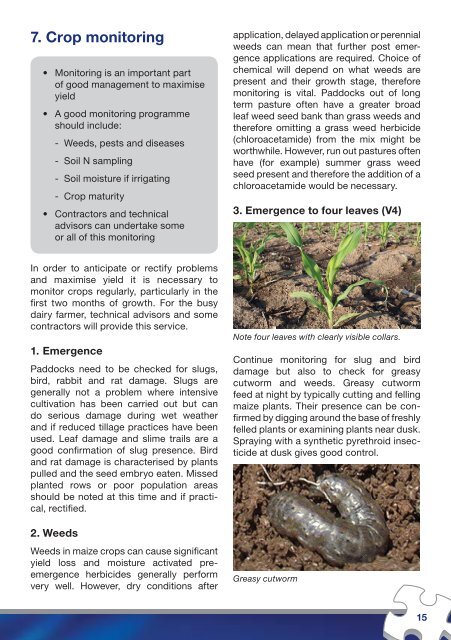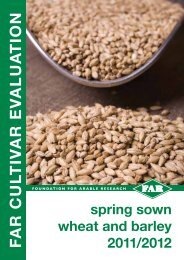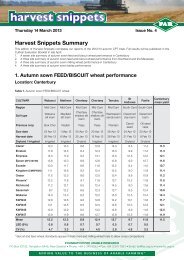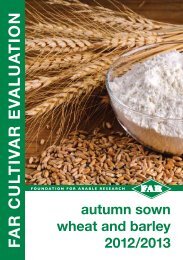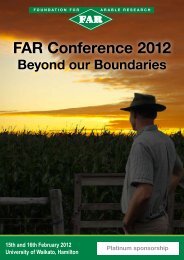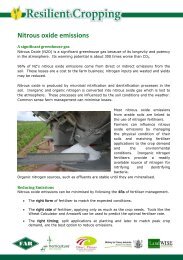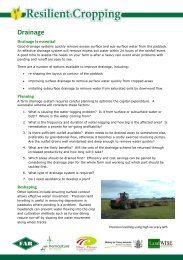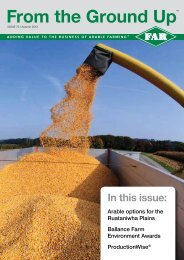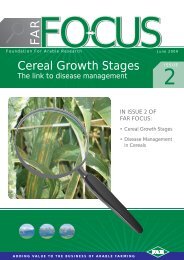Best Management Practices for Growing Maize on Dairy Farms
Best Management Practices for Growing Maize on Dairy Farms
Best Management Practices for Growing Maize on Dairy Farms
- No tags were found...
You also want an ePaper? Increase the reach of your titles
YUMPU automatically turns print PDFs into web optimized ePapers that Google loves.
7. Crop m<strong>on</strong>itoring• M<strong>on</strong>itoring is an important partof good management to maximiseyield• A good m<strong>on</strong>itoring programmeshould include:- Weeds, pests and diseases- Soil N sampling- Soil moisture if irrigating- Crop maturity• C<strong>on</strong>tractors and technicaladvisors can undertake someor all of this m<strong>on</strong>itoringapplicati<strong>on</strong>, delayed applicati<strong>on</strong> or perennialweeds can mean that further post emergenceapplicati<strong>on</strong>s are required. Choice ofchemical will depend <strong>on</strong> what weeds arepresent and their growth stage, there<str<strong>on</strong>g>for</str<strong>on</strong>g>em<strong>on</strong>itoring is vital. Paddocks out of l<strong>on</strong>gterm pasture often have a greater broadleaf weed seed bank than grass weeds andthere<str<strong>on</strong>g>for</str<strong>on</strong>g>e omitting a grass weed herbicide(chloroacetamide) from the mix might beworthwhile. However, run out pastures oftenhave (<str<strong>on</strong>g>for</str<strong>on</strong>g> example) summer grass weedseed present and there<str<strong>on</strong>g>for</str<strong>on</strong>g>e the additi<strong>on</strong> of achloroacetamide would be necessary.3. Emergence to four leaves (V4)In order to anticipate or rectify problemsand maximise yield it is necessary tom<strong>on</strong>itor crops regularly, particularly in thefirst two m<strong>on</strong>ths of growth. For the busydairy farmer, technical advisors and somec<strong>on</strong>tractors will provide this service.1. EmergencePaddocks need to be checked <str<strong>on</strong>g>for</str<strong>on</strong>g> slugs,bird, rabbit and rat damage. Slugs aregenerally not a problem where intensivecultivati<strong>on</strong> has been carried out but cando serious damage during wet weatherand if reduced tillage practices have beenused. Leaf damage and slime trails are agood c<strong>on</strong>firmati<strong>on</strong> of slug presence. Birdand rat damage is characterised by plantspulled and the seed embryo eaten. Missedplanted rows or poor populati<strong>on</strong> areasshould be noted at this time and if practical,rectified.2. WeedsWeeds in maize crops can cause significantyield loss and moisture activated preemergenceherbicides generally per<str<strong>on</strong>g>for</str<strong>on</strong>g>mvery well. However, dry c<strong>on</strong>diti<strong>on</strong>s afterNote four leaves with clearly visible collars.C<strong>on</strong>tinue m<strong>on</strong>itoring <str<strong>on</strong>g>for</str<strong>on</strong>g> slug and birddamage but also to check <str<strong>on</strong>g>for</str<strong>on</strong>g> greasycutworm and weeds. Greasy cutwormfeed at night by typically cutting and fellingmaize plants. Their presence can be c<strong>on</strong>firmedby digging around the base of freshlyfelled plants or examining plants near dusk.Spraying with a synthetic pyrethroid insecticideat dusk gives good c<strong>on</strong>trol.Greasy cutworm15


